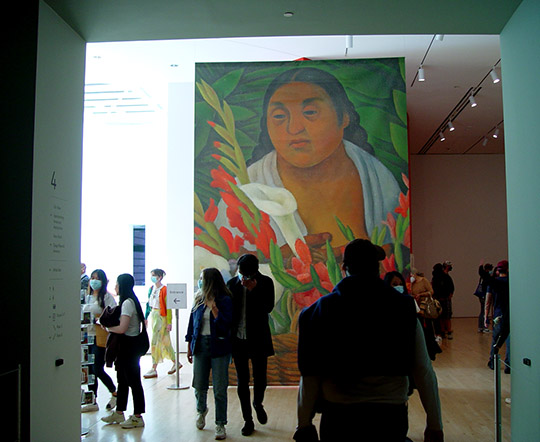A huge exhibition of Mexican artist Diego Rivera's work from the 1920s to the 1940s has opened at SFMOMA, and it is drawing large crowds.
Though I love Mexican art and its 20th century muralists, Rivera's work has not been aging well for me, and this exhibition managed to confirm all those prejudices.
His socialist realism style depicting los indios of Mexico now often looks like dated, earnest kitsch. Interestingly, the art of his fellow Mexican communist and muralist José Clemente Orozco is aging brilliantly, and so are the surrealist self-portraits of Rivera's wife Frida Kahlo whose work was virtually unknown outside of a small cult until the 1980s.
On the top floor of the museum is a highly conceptual exhibit called Shifting the Silence, featuring 32 contemporary women artists. The curators write: "[These 32 artists] use the radical language of abstraction to enhance our understanding of the world we inhabit. Named after artist Etel Adnan’s 2020 book about history and existence, Shifting the Silence embraces experimentation, impermanence, and subjectivity — bold yet poetic characteristics that mark the art of our time...The exhibition harnesses their defiant, yet enlightened energy to explore visual culture, the motivations of its practitioners, and its varied influences." Though the artspeak is ridiculous, some of the art is delightful, such as the 2004 painting Stadia I by Julie Mehretu.
In a dark, scary room of its own, a series of mirrors and metal grids hang from the ceiling in Haegue Yuang's 2008 yearning melancholy red. The cool part of the piece is a drum set hidden in a dark corner, complete with cymbals, that any patron is welcome to play, and when they do so, a series of lights throughout the room respond to the sounds. Don't be shy and be sure to get a few licks in yourself because it's tremendous fun.
When I told the smart, amusing ticket woman that the Rivera was a disappointment, she said, "Be sure to go to the Sightlines photo exhibit on the third floor." She was right.
In this exhibit, the curators have done a marvelous job of offering an eclectic sampler of photography from the museum's permanent collection, and it's filled with treasures without being bogged down by art theory.













No comments:
Post a Comment